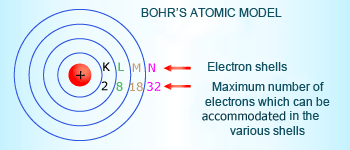 Bohr's Atomic Model
Bohr's Atomic Model
To exactly explain why we fill such shell structures and why we can accommodate different numbers of electrons, a new mechanics, called quantum mechanics, was developed to understand the behavior of atomic electrons. Quantum mechanics was developed by many scientists but Schrodinger, Heisenberg, Plank, Bohr, Pauli, were some of the major contributors. A total of four quantum numbers were developed to better understand the movement and pathway of electrons in its designated orbital within an atom. Each electron in an atom has a unique set of quantum numbers; no two electrons can share the same combination of four quantum numbers. Quantum numbers are very significant because they can determine the electron configuration of an atom and a probable location of the atom's electrons.
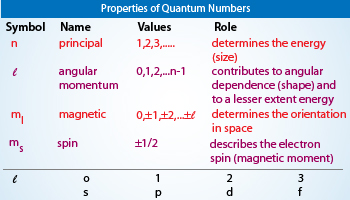 Table Showing Properties Of Quantum Numbers
Table Showing Properties Of Quantum Numbers
The Four Quantum Numbers :
- Principal Quantum Number.
- Orbital Angular Momentum / Azimuthal Quantum Number.
- Magnetic Quantum Number.
- Electron Spin Quantum Number.
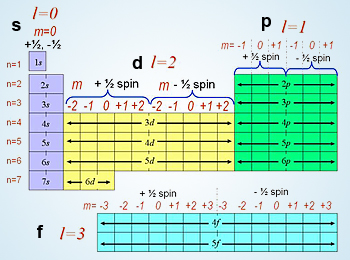 Periodic Table With Quantum Numbers
Periodic Table With Quantum Numbers
Quantum numbers :
Quantum numbers designate specific levels, sub shells, orbitals, and spins of electrons. This means that they are describing in
detail the characteristics of the electrons in the atoms. There are a total of four quantum numbers: the principal quantum number
(n), the orbital angular momentum quantum number (l), the magnetic quantum number (ml), and the electron spin quantum
number (ms) The principal quantum number, n, describes the energy of an electron and the most probable distance of the electron
from the nucleus. In other words, it is referring to the size of the orbital and the energy level an electron is placed in. The
number of sub shells, or, describes the shape of the orbital. You can also use l to find the number of angular nodes. The
magnetic quantum number, ml, describes the amount of energy levels in a sub shell. ms is referring to the spin on the electron,
which can either be up or down.
| Principal Quantum Number (n) | Shell letters | Values | Number of electrons in each sub shell | |||
|---|---|---|---|---|---|---|
| s | p | d | f | |||
| 1 | K | 0 | 2 | |||
| 2 | L | 0 | 1 | 2,6 | ||
| 3 | M | 0 | 1 | 2 | 2,6,10 | |
| 4 | N | 0 | 1 | 2 | 3 | 2,6,10,14 |
Principal Quantum Number :
The principal quantum number, n, designates the principal electron shell. Because n describes the most probable distance of the
electrons from the nucleus, the larger the number n is, the farther the electrons are from the nucleus, the larger the size of
the orbital, and the larger the atom is. n can be any positive integer starting at 1, as n=1 designates the first principal shell
(the innermost shell). The first principal shell is also called the ground state, or lowest energy state. When an electron is in
an excited state or it gains energy, it may jump to the second principle shell, where n=2. This is called absorption because the
electron is “absorbing” photons, or energy. Known as emission, electrons can also “emit” energy as they
jump to lower principle shells, where n decreases by whole numbers.
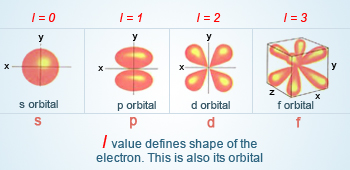 Shapes of Orbitals
Shapes of Orbitals
Orbital angular momentum quantum number:
The orbital angular momentum quantum number l determines the shape of an orbital, and therefore the angular distribution.
The number of angular nodes is equal to the value of the angular momentum quantum number l. (For more information about
angular nodes, see (Electronic Orbitals.) Each value of l indicates a specific s, p, d, f sub shell (each unique in shape.)
The value of l is dependent on the principal quantum number n. Unlike n, the value of l can be zero. It can also be
a positive integer, but it cannot be larger than one less than the principal quantum number (n−1): l=0,1, 2, 3, 4…,
(n−1)
Magnetic Quantum Number :
The magnetic quantum number ml determines the number of orbitals and their orientation within a sub shell. Consequently, its value
depends on the orbital angular momentum quantum number l. Given a certain l, ml is an interval ranging from −l to +l,
so it can be zero, a negative integer, or a positive integer.
ml= −l, (−l +1),(−l +2),…, −2, −1, 0, 1, 2, … (l − 1),
(l−2), +l
Spin Quantum Number :
Unlike n, l, and ml, the electron spin quantum number ms does not depend on another quantum number. It designates the direction of
the electron spin and may have a spin of +1/2, represented by ↑, or −1/2, represented by ↓. This means
that when ms is positive the electron has an upward spin, which can be referred to as “spin up”. When it is negative,
the electron has a downward spin, so it is “spin down”.
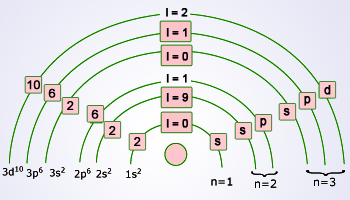 The picture depicts the various shells, sub–shells and their nomenclature. The shells are known
as K, L, M and so on. Each shell has definite principal quantum number, n and sub shells of l can also be seen.
The picture depicts the various shells, sub–shells and their nomenclature. The shells are known
as K, L, M and so on. Each shell has definite principal quantum number, n and sub shells of l can also be seen.
A Closer Look at Shells, Sub shells, and Orbitals :
Principal Shells
The value of the principal quantum number n is the level of the principal electronic shell (principal level). All orbitals that
have the same n value are in the same principal level. For example, all orbitals on the second principal level have a principal
quantum number of n=2. When the value of n is higher, the number of principal electronic shells is greater.
| Name of Sub shell | Value of l |
|---|---|
| s sub shell | 0 |
| p sub shell | 1 |
| d sub shell | 2 |
| f sub shell | 3 |
Sub shells :
The number of values of the orbital angular number l can also be used to identify the number of sub shells in a principal
electron shell:
- When n = 1, l = 0 (l takes on one value and thus there can only be one sub shell)
- When n = 2, l = 0, 1 (l takes on two values and thus there are two possible sub shells)
- When n = 3, l = 0, 1, 2 (l takes on three values and thus there are three possible sub shells)
To identify what type of possible sub shells n has, these sub shells have been assigned letter names. The value of l determines the name of the sub shell:
| s orbitals | p orbitals | d orbitals | f orbitals | |
|---|---|---|---|---|
| l | 0 | 1 | 2 | 3 |
| ml | 0 | −1, 0, +1 | −2, −1, 0, +1, +2 | −3, −2, −1, 0, +1, +2, +3 |
| Number of orbitals in designated | 1 | 3 | 5 | 7 |
| sub shell | s | p | d | f |
Orbitals :
The number of orbitals in a sub shell is equivalent to the number of values the magnetic quantum number ml takes on. A helpful
equation to determine the number of orbitals in a sub shell is 2l +1. This equation will not give you the value of ml, but
the number of possible values that ml can take on in a particular orbital. For example, if l=1 and ml can have
values −1, 0, or +1, the value of 2l+1 will be three and there will be three different orbitals. The names of the
orbitals are named after the sub shells they are found in the table.